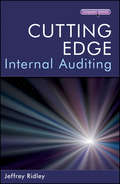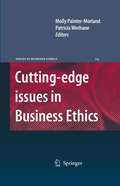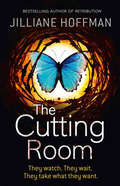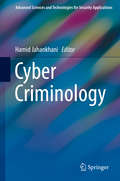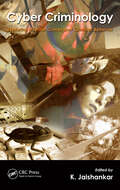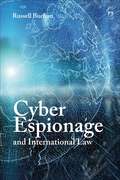- Table View
- List View
Customer Value, Shareholder Wealth, Community Wellbeing: A Roadmap for Companies and Investors
by Denis Kilroy Marvin SchneiderThis book provides a roadmap for leaders of listed companies to follow in order to build enduring institutions that create value for customers and wealth for shareholders on an ongoing basis, in ways that also enhance the wellbeing of all other legitimate stakeholders – including the wider community and the environment.Customer Value, Shareholder Wealth, Community Wellbeing is an inspirational work that confirms the very positive role that a more expansive, more inclusive and more conscious approach to business, can play within our society. It incorporates a breakthrough in understanding in applied corporate finance and business economics centred on the Bow Wave of Expected Economic Profits. This construct provides an economic underpinning for a new and more socially responsible business paradigm – demonstrating for the first time exactly how the performance produced by management in the market for their company’s products and services, translates into the capital market outcomes experienced by shareholders.
Customs Law in the European Union: Legal, Doctrinal and Jurisprudential Framework (Global Trade Law Series)
by José RijoThe regulation of imports and exports by customs authorities profoundly affects the activity of economic operators in international trade. This is (one of) the first book(s) in English to critically assess the legal instruments of the European Union’s trade and customs policy—namely the Union Customs Code and its regulatory instruments—taking account of doctrinal contributions and the jurisprudential acquis of the Court of Justice of the European Union. With unparalleled guidance for the adoption of the best customs solutions for international trade operations, the book covers such crucial elements of relevant law and procedure as the following: submission of goods to customs; types of customs declaration; the EU’s harmonized commodity description and coding system; setting of import and export duties; evaluation of the customs value of goods; determination of tariff quotas or suspensions; collection and payment of duties; proof of origin of goods; preferential arrangements: FTAs and GSP; customs debt and guarantees; issues raised by under-evaluation and under-invoicing of goods and false certifications of the origin of goods; effect of unfair competition practices (dumping and trade defense); right to appeal customs authority decisions; storage; and taxation. The complexity of customs requirements and procedures imposes on businesses the necessity to become familiar with the intricate mechanisms deriving from customs law. This book will prove an indispensable tool for all companies involved with import/export to and from Europe. It will be welcomed worldwide by in-house counsel, purchasing and supply chain departments, customs brokers, logistic and forwarding operators, customs officers, and interested academics both in and outside the European Union.
Customs Law of East Asia
by Chia-Jui ChengThe countries comprising East Asia have experienced impressive economic growth and made substantial moves to liberalize trade policies. In light of the region’s remarkable impact on global commerce, international trade professionals minimize the importance of local customs law at their peril. This timely work reflects the insights of an impressive array of experts and is designed to be a practical source of context and guidance. Readers will quickly discover it to be an indispensable tool to unravel many of the trade-related challenges and opportunities the region offers.
Customs Law of the European Union
by Massimo FabioToday, global competition obliges companies dealing in international trade to modernize their procedures of delivery in order to minimize the customs burden and simplify the relation with customs authorities. Customs planning is the current option to be effective in the worldwide marketplace. However, customs officials are facing new challenges: they must ensure the smooth flow of trade while applying necessary controls on the one hand, while protecting the health and safety of the Community's citizens on the other. To achieve and maintain the correct balance between these demands, control methods are constantly evolving raising major challenges to those charged with planning and compliance. This book is a highly practical work dealing with the ins and outs of European Union (EU) customs law. Cases of study, jurisprudence and comparative law support the analysis of the different legal tools. The consolidated principles ruling the transactions within WTO Member States applied in EU law offer the readers the opportunity to understand how customs rules can be applied in any customs jurisdiction. Authored by an international tax lawyer with extensive experience enforcing EU customs law as a former member of Italy’s financial police, this handy resource is designed to help the reader stay in compliance with the laws controlling EU importing and exporting while structuring transactions in a business-friendly manner.
Customs Unions in the WTO: Problems with Anti-Dumping (European Yearbook of International Economic Law #20)
by Fabian BickelHow the WTO deals with regional trade agreements (RTAs) is conceptually and practically one of the most important questions in international trade law. This book clarifies that relationship focussing on one form of regional integration – customs unions – and one form of trade measures – anti-dumping measures. This book answers the question how anti-dumping measures and legislation change if a state is in a customs union as well. In doing so, this book provides a new reasoning why anti-dumping measures are modified in customs unions, as well as a comprehensive overview of how this has happened, a legal analysis on the legality of these changes, and an answer to the question how the different institutional settings have impacted questions of responsibility and attribution. Going beyond this, this book also considers the specific problems that arise in cases of economic integration and disintegration, and finally, the impact forming a customs union has on third parties that may impose anti-dumping measures on states that are members of a customs union.
The Customs Valuation Agreement: Origin, Standards and Interpretations (Global Trade Law Series)
by Mark K. NevilleGlobal Trade Law Series, Volume 58 Customs valuation is a key element in the corpus of international trade law. Despite the facts that the /WTO Valuation Agreement 1994 remains unchanged in all material respects and that it has been adopted by virtually every trading nation on the planet, there are fissures in the system preventing consensus on many contentious questions. This extremely knowledgeable analysis by a world-renowned specialist lawyer in the field—by concentrating on diverging views on the nature of the central feature of the Agreement, the definition of the price actually paid or payable (PAPP)—provides the most extensive study available of the origins and architecture of the Valuation Agreement and its intersection with transfer pricing norms. Among much else, the author fully explains differing views on such questions as the following: criteria governing royalties and license fees; acceptability of the First Sale for Export doctrine; role of transport charges in valuing dutiable assists; status of interest payments on deferred payments; valuation of carrier media bearing software for data processing equipment; inclusion or exclusion of transport charges in the PAPP; status of the WTO’s moratorium on electronic transmissions; status of payments of money for tools and other materials used in producing the imported goods; and status of international instruments of traffic. The author expertly assesses interpretations of the Valuation Agreement as presented in the instruments of the World Customs Organization and in the administrative and judicial fora of the United States, Canada, and the European Union. This matchless book takes a giant step toward “real-world” consensus on the daunting questions of custom valuation. Customs and international tax professionals, as well as academic scholars, will come away from its in-depth coverage with an enhanced ability to discern the logic inherent in the Valuation Agreement, a greater awareness of current trends and their origins in authoritative customs valuation bodies, and improved confidence when approaching customs valuation questions.
Customs Valuation and Transfer Pricing: Is it Possible to Harmonize Customs and Tax Rules?
by Juan Martin JovanovichIssues of transfer pricing have come to the fore in both international tax and customs regimes. In particular, the problem of how to apply the two systems of valuation to the same transaction is of widespread concern. This well-known book, now in a fully updated second edition, is a problem-solving guide for professionals charged with valuating transactions in their client’s or company’s best interests. Through detailed examination of relevant guidelines, transfer pricing methodologies, and business realities prevailing among multinational enterprises, it offers a cogent and convincing account of how tax and customs transfer pricing regimes may be harmonized. Among other essential elements, the author discusses the following in depth: – the OECD Transfer Pricing Guidelines; – the GATT/WTO Customs Valuation Code (GVC) and other valuation rules in key jurisdictions and regional agreements; – the OECD and UN model tax conventions; – the arm’s length principle; – methods, both traditional and new, of determining whether the parties’ relationship in uenced the price; and – additions to and deductions from the customs value. This second edition discusses new developments in the eld, including a chapter on Commentary 23.1 and Case Study 14.1 of the Technical Committee on Customs Valuation of the World Customs Organization (WCO) – the rst international instruments linking transfer pricing and customs valuation. The book concludes with an analysis of the circumstances and conditions under which the introduction of transfer pricing year-end adjustments to transaction value would be consistent with Article 1 of the GVC. The book will continue to provide practitioners, customs administrations, and academics with a highly practical analysis of the intersection of transfer pricing and customs valuation. It will be welcomed by customs administrations charged with examining the acceptability of a transaction value xed between related parties and by multinational companies as a truly actionable tool they can use to optimize decision-making as it relates to transfer pricing and customs valuation in a “real world” setting.
Cuts and Criminality: Body Alteration in Legal Discourse
by Theodore BennettThis book investigates how and why the criminal law differentiates between different types of body alterations, with particular reference to how they are conceptualised within legal discourse. By drawing connections between types of body alteration that have traditionally been considered separately and discretely, the book allows analytical conclusions to be made about the law’s treatment of the general category of ’body alteration’ rather than merely about specific types of body alteration. Taking legal discourse as its analytical focus, the author critically examines a number of case studies to determine the techniques and processes by which some body alterations are discursively constructed as legitimate and legally approved, and by which other body alterations are discursively constructed as illegitimate and legally sanctioned. Specifically, the body alterations that are addressed include sadomasochistic injuries; female genital modification and male circumcision; cosmetic surgery, body modification and healthy limb amputation; and sex reassignment surgery and genital ’normalisation’ surgery. International in scope, the discursive analysis in the book will be of interest to academics and researchers working in the areas of socio-legal and cultural studies.
Cuts and Criminality: Body Alteration in Legal Discourse
by Theodore BennettThis book investigates how and why the criminal law differentiates between different types of body alterations, with particular reference to how they are conceptualised within legal discourse. By drawing connections between types of body alteration that have traditionally been considered separately and discretely, the book allows analytical conclusions to be made about the law’s treatment of the general category of ’body alteration’ rather than merely about specific types of body alteration. Taking legal discourse as its analytical focus, the author critically examines a number of case studies to determine the techniques and processes by which some body alterations are discursively constructed as legitimate and legally approved, and by which other body alterations are discursively constructed as illegitimate and legally sanctioned. Specifically, the body alterations that are addressed include sadomasochistic injuries; female genital modification and male circumcision; cosmetic surgery, body modification and healthy limb amputation; and sex reassignment surgery and genital ’normalisation’ surgery. International in scope, the discursive analysis in the book will be of interest to academics and researchers working in the areas of socio-legal and cultural studies.
Cutting Edge Internal Auditing
by Jeffrey RidleyCutting Edge Internal Auditing provides guidance and knowledge for every internal auditor, encouraging each to pioneer new ground in the development of their professional practices in all risk management, control and governance processes. Serving as an excellent reference guide that develops a pattern of internal auditing now and for the future, this book explores the concept of 'cutting edge' internal auditing as an imaginative adventure: demonstrating how this has influenced and will continue to influence the development of professionalism in internal auditing. Built on the foundations of Jeffrey Ridley's extensive internal auditing experience across the public and private sectors, the author uses his articles and research to explore and develop the motivations, goals and categories of innovation in internal auditing today. It develops and brings up to date an imaginative internal auditing model, created and used by the author in the early 1980s, drawing on research and guidance by The Institute of Internal Auditors Inc., its Research Foundation and the Institute of Internal Auditors - UK and Ireland. Each chapter stands alone by focusing on an individual internal auditing theme, considered from both the perspective of internal auditing and its customers to suggest an appropriate vision as a goal for every internal audit activity. Each chapter also includes self-assessment questions to challenge the readers understanding of its messages. Companion website contains some of the author's training slides and seventy case studies, many written by leading internal audit practitioners, this book creates a vision for future cutting edge internal auditing.
Cutting-edge Issues in Business Ethics: Continental Challenges to Tradition and Practice (Issues in Business Ethics #24)
by Patricia Werhane Mollie Painter-MorlandBusiness ethics originated in the United States as an offshoot of theoretical ethics and as part of a movement in applied ethics that was initiated with medical ethics. Although a few small religious-based colleges and universities offered courses in business ethics just after the Second World War, business ethics as an academic ?eld developed most seriously in many universities in the early 1970s. The ?eld of medical ethics was well-developed by then, and it was a natural step to think about ethical issues in business as well. There was also a public reaction to a number of corporate scandals (e.g., price ?xing, the Lockheed Japanese bribery allegations, the Goodyear airbrake scandal, etc. that encouraged universities to begin teaching the subject). Business ethics as an academic ?eld was originally developed by philosophers, most of whom had come out of the analytic or Anglo-American philosophical tra- tions and who had been trained in classical ethics, on Aristotle, Kant, Mill, Bentham and perhaps Dewey. The resulting ?eld then, has been dominated by this thinking. Although to date there are over 50 textbooks in business ethics, most textbooks in business ethics do not take into account contemporary continental philosophy. Although Marxism is sometimes taught in these courses, other more contemporary continental thinkers who could contribute substantially to the ?eld have been - nored. This phenomenon is iterated in the professional journals and in theoretical books on the topic.
Cutting Green Tape: Pollutants, Environmental Regulation and the Law
by Roger MeinersHundreds of hazardous waste sites are on the Superfund National Priority List in the United States, and thousands more could become eligible. The Superfund has spent or ordered the spending of billions of dollars, with little apparent impact on human health risks. While public perception of the real or imagined hazardous nature of consumer and industrial substances has resulted in widespread attention to the issue, lawsuits have proliferated with liability aimed at "deep pockets" instead of individual agents who may be responsible. Contributors to Cutting Green Tape carefully examine the existence and severity of the toxic harms and liability problem, the erosion of a clear tort legal system to settle disputes, and whether a clearly defined system of property rights could be developed to reduce the dangers from toxic substances.Cutting Green Tape rethinks the nature and impact of today's environmental bureaucracy. Rather than continue unworkable, cumbersome, and often contradictory regulations, Cutting Green Tape prescribes a clearer tort legal system to settle disputes and demonstrates that clearly defined environmental property rights would reduce the threat of toxic substances. Among the many topics addressed are: air toxins policy; pollution, damages, and tort law; risk assessment, insurance, and public information; protecting groundwater; regulation of carcinogens; contracting for health and safety; and toxin torts by government.The book converges on a central theme: when common law remedies, with their burden of proof and standards of evidence, are replaced by the legislatively mandated regulatory regimes described, a problem emerges. The bureaucratic "tunnel vision" described by Justice Stephen Breyer, tends to take over. The police powers of the state are given to bureaucratic decision makers who are limited only by the blunt instrument of political influence, rather than by the need to show harm or wrongdoing in an unbiased court (as the police are), or by a budget on expenditures set by the Congress (as most bureaus are). The excesses described in the chapters thus result not from incompetence in the bureaus, but from the expansive powers granted to decision makers who are tightly focused on the narrow mission they see before them.
Cutting Green Tape: Pollutants, Environmental Regulation and the Law
by Richard L. Stroup Roger E. MeinersHundreds of hazardous waste sites are on the Superfund National Priority List in the United States, and thousands more could become eligible. The Superfund has spent or ordered the spending of billions of dollars, with little apparent impact on human health risks. While public perception of the real or imagined hazardous nature of consumer and industrial substances has resulted in widespread attention to the issue, lawsuits have proliferated with liability aimed at "deep pockets" instead of individual agents who may be responsible. Contributors to Cutting Green Tape carefully examine the existence and severity of the toxic harms and liability problem, the erosion of a clear tort legal system to settle disputes, and whether a clearly defined system of property rights could be developed to reduce the dangers from toxic substances.Cutting Green Tape rethinks the nature and impact of today's environmental bureaucracy. Rather than continue unworkable, cumbersome, and often contradictory regulations, Cutting Green Tape prescribes a clearer tort legal system to settle disputes and demonstrates that clearly defined environmental property rights would reduce the threat of toxic substances. Among the many topics addressed are: air toxins policy; pollution, damages, and tort law; risk assessment, insurance, and public information; protecting groundwater; regulation of carcinogens; contracting for health and safety; and toxin torts by government.The book converges on a central theme: when common law remedies, with their burden of proof and standards of evidence, are replaced by the legislatively mandated regulatory regimes described, a problem emerges. The bureaucratic "tunnel vision" described by Justice Stephen Breyer, tends to take over. The police powers of the state are given to bureaucratic decision makers who are limited only by the blunt instrument of political influence, rather than by the need to show harm or wrongdoing in an unbiased court (as the police are), or by a budget on expenditures set by the Congress (as most bureaus are). The excesses described in the chapters thus result not from incompetence in the bureaus, but from the expansive powers granted to decision makers who are tightly focused on the narrow mission they see before them.
The Cutting Room: 2-book Thriller Collection (C. J. Townsend Thriller Ser. #3)
by Jilliane HoffmanThe chilling new psychological thriller from the bestselling author of Retribution and Pretty Little Things
Cyber Attack Information System: Erfahrungen und Erkenntnisse aus der IKT-Sicherheitsforschung (Xpert.press)
by Helmut Leopold Thomas Bleier Florian SkopikIn den letzten Jahren hat sich das Internet schnell zu einem massiven wirtschaftlichen Betätigungsfeld entwickelt, leider auch für illegale Unternehmungen. Das Ausnutzen von Schwachstellen in IKT-Systemen ist inzwischen ein profitables Geschäftsmodell. Das staatlich geförderte Forschungsprojekt CAIS beschäftigte sich deshalb mit der Implementierung eines Cyber Attack Information Systems auf nationaler Ebene mit dem Ziel, die Widerstandsfähigkeit der heutigen vernetzten Systeme zu stärken und ihre Verfügbarkeit und Vertrauenswürdigkeit zu erhöhen. Hauptziele dieses Projektes waren die Identifizierung der künftigen Cyber-Risiken und -Bedrohungen, die Untersuchung neuartiger Techniken zur Anomalieerkennung, die Entwicklung modularer Infrastrukturmodelle und agentenbasierter Simulationen zur Risiko- und Bedrohungsanalyse, und schließlich die Analyse und mögliche Umsetzung eines nationalen Cyber Attack Information Systems.
Cyber Consumer Law and Unfair Trading Practices (Markets and the Law)
by Cristina CoteanuOf great interest to practitioners, policymakers and academics - as well as to consumers and traders in general - this timely work addresses all important legal and practical issues that arise in connection with online trading. This important work outlines the existing legislation and legal jurisprudence in the EU and the US and exposes the potential for unfair commercial practices to arise from online contracts, electronic agents, disclosure of information, online advertising and online dispute resolution in cross-border transactions. The continuing prevalence of unfair commercial practices will ensure this book remains in great demand.
Cyber Consumer Law and Unfair Trading Practices (Markets and the Law)
by Cristina CoteanuOf great interest to practitioners, policymakers and academics - as well as to consumers and traders in general - this timely work addresses all important legal and practical issues that arise in connection with online trading. This important work outlines the existing legislation and legal jurisprudence in the EU and the US and exposes the potential for unfair commercial practices to arise from online contracts, electronic agents, disclosure of information, online advertising and online dispute resolution in cross-border transactions. The continuing prevalence of unfair commercial practices will ensure this book remains in great demand.
Cyber Crime, Security and Digital Intelligence
by Mark JohnsonToday's digital economy is uniquely dependent on the Internet, yet few users or decision makers have more than a rudimentary understanding of the myriad of online risks that threaten us. Cyber crime is one of the main threats to the integrity and availability of data and systems. From insiders to complex external attacks and industrial worms, modern business faces unprecedented challenges; and while cyber security and digital intelligence are the necessary responses to this challenge, they are understood by only a tiny minority. In his second book on high-tech risks, Mark Johnson goes far beyond enumerating past cases and summarising legal or regulatory requirements. He describes in plain, non-technical language how cyber crime has evolved and the nature of the very latest threats. He confronts issues that are not addressed by codified rules and practice guidelines, supporting this with over 30 valuable illustrations and tables. Written for the non-technical layman and the high tech risk manager alike, the book also explores countermeasures, penetration testing, best practice principles, cyber conflict and future challenges. A discussion of Web 2.0 risks delves into the very real questions facing policy makers, along with the pros and cons of open source data. In a chapter on Digital Intelligence readers are provided with an exhaustive guide to practical, effective and ethical online investigations. Cyber Crime, Security and Digital Intelligence is an important work of great relevance in today's interconnected world and one that nobody with an interest in either risk or technology should be without.
Cyber Crime, Security and Digital Intelligence: Vulnerabilities Risks Threat Actors And Controls In The Information Age
by Mark JohnsonToday's digital economy is uniquely dependent on the Internet, yet few users or decision makers have more than a rudimentary understanding of the myriad of online risks that threaten us. Cyber crime is one of the main threats to the integrity and availability of data and systems. From insiders to complex external attacks and industrial worms, modern business faces unprecedented challenges; and while cyber security and digital intelligence are the necessary responses to this challenge, they are understood by only a tiny minority. In his second book on high-tech risks, Mark Johnson goes far beyond enumerating past cases and summarising legal or regulatory requirements. He describes in plain, non-technical language how cyber crime has evolved and the nature of the very latest threats. He confronts issues that are not addressed by codified rules and practice guidelines, supporting this with over 30 valuable illustrations and tables. Written for the non-technical layman and the high tech risk manager alike, the book also explores countermeasures, penetration testing, best practice principles, cyber conflict and future challenges. A discussion of Web 2.0 risks delves into the very real questions facing policy makers, along with the pros and cons of open source data. In a chapter on Digital Intelligence readers are provided with an exhaustive guide to practical, effective and ethical online investigations. Cyber Crime, Security and Digital Intelligence is an important work of great relevance in today's interconnected world and one that nobody with an interest in either risk or technology should be without.
Cyber Criminology (Advanced Sciences and Technologies for Security Applications)
by Hamid JahankhaniThis book provides a comprehensive overview of the current and emerging challenges of cyber criminology, victimization and profiling. It is a compilation of the outcomes of the collaboration between researchers and practitioners in the cyber criminology field, IT law and security field.As Governments, corporations, security firms, and individuals look to tomorrow’s cyber security challenges, this book provides a reference point for experts and forward-thinking analysts at a time when the debate over how we plan for the cyber-security of the future has become a major concern. Many criminological perspectives define crime in terms of social, cultural and material characteristics, and view crimes as taking place at a specific geographic location. This definition has allowed crime to be characterised, and crime prevention, mapping and measurement methods to be tailored to specific target audiences. However, this characterisation cannot be carried over to cybercrime, because the environment in which such crime is committed cannot be pinpointed to a geographical location, or distinctive social or cultural groups. Due to the rapid changes in technology, cyber criminals’ behaviour has become dynamic, making it necessary to reclassify the typology being currently used. Essentially, cyber criminals’ behaviour is evolving over time as they learn from their actions and others’ experiences, and enhance their skills. The offender signature, which is a repetitive ritualistic behaviour that offenders often display at the crime scene, provides law enforcement agencies an appropriate profiling tool and offers investigators the opportunity to understand the motivations that perpetrate such crimes. This has helped researchers classify the type of perpetrator being sought. This book offers readers insights into the psychology of cyber criminals, and understanding and analysing their motives and the methodologies they adopt. With an understanding of these motives, researchers, governments and practitioners can take effective measures to tackle cybercrime and reduce victimization.
Cyber Criminology: Exploring Internet Crimes and Criminal Behavior
by K. JaishankarVictimization through the Internet is becoming more prevalent as cyber criminals have developed more effective ways to remain anonymous. And as more personal information than ever is stored on networked computers, even the occasional or non-user is at risk. A collection of contributions from worldwide experts and emerging researchers, Cyber Crimino
Cyber-Development, Cyber-Democracy and Cyber-Defense: Challenges, Opportunities and Implications for Theory, Policy and Practice
by Elias G. Carayannis David F. J. Campbell Marios Panagiotis EfthymiopoulosIn this volume, contributors from academia, industry, and policy explore the inter-connections among economic development, socio-political democracy and defense and security in the context of a profound transformation, spurred by globalization and supported by the rapid development of information and communication technologies (ICT). This powerful combination of forces is changing the way we live and redefining the way companies conduct business and national governments pursue strategies of innovation, economic growth and diplomacy.Integrating theoretical frameworks, empirical research and case studies, the editors and contributors have organized the chapters into three major sections, focusing on cyber-development, cyber-democracy and cyber-defense.The authors define cyber-development as a set of tools, methodologies and practices that leverage ICT to catalyze and accelerate social, political and economic development, with an emphasis on making the transition to knowledge-based economies. One underlying understanding here is that knowledge, knowledge creation, knowledge production and knowledge application (innovation) behave as crucial drivers for enhancing democracy, society, and the economy. By promoting dissemination and sharing of knowledge, cyber-democracy allows a knowledge conversion of the local into the global (gloCal) and vice versa, resulting in a gloCal platform for communication and knowledge interaction and knowledge enhancement. Meanwhile, technology-enabled interconnectivity increases the need to adopt new methods and actions for protection against existing threats and possible challenges to emerge in the future. The final section contemplates themes of cyber-defense and security, as well as emerging theories and values, legal aspects and trans-continental links (NATO, international organizations and bilateral relations between states). Collectively, the authors present a unique collection of insights and perspectives on the challenges and opportunities inspired by connectivity.
Cyber Espionage and International Law
by Russell BuchanThe advent of cyberspace has led to a dramatic increase in state-sponsored political and economic espionage. This monograph argues that these practices represent a threat to the maintenance of international peace and security and assesses the extent to which international law regulates this conduct. The traditional view among international legal scholars is that, in the absence of direct and specific international law on the topic of espionage, cyber espionage constitutes an extra-legal activity that is unconstrained by international law. This monograph challenges that assumption and reveals that there are general principles of international law as well as specialised international legal regimes that indirectly regulate cyber espionage. In terms of general principles of international law, this monograph explores how the rules of territorial sovereignty, non-intervention and the non-use of force apply to cyber espionage. In relation to specialised regimes, this monograph investigates the role of diplomatic and consular law, international human rights law and the law of the World Trade Organization in addressing cyber espionage. This monograph also examines whether developments in customary international law have carved out espionage exceptions to those international legal rules that otherwise prohibit cyber espionage as well as considering whether the doctrines of self-defence and necessity can be invoked to justify cyber espionage. Notwithstanding the applicability of international law, this monograph concludes that policymakers should nevertheless devise an international law of espionage which, as lex specialis, contains rules that are specifically designed to confront the growing threat posed by cyber espionage.
Cyber Espionage and International Law
by Russell BuchanThe advent of cyberspace has led to a dramatic increase in state-sponsored political and economic espionage. This monograph argues that these practices represent a threat to the maintenance of international peace and security and assesses the extent to which international law regulates this conduct. The traditional view among international legal scholars is that, in the absence of direct and specific international law on the topic of espionage, cyber espionage constitutes an extra-legal activity that is unconstrained by international law. This monograph challenges that assumption and reveals that there are general principles of international law as well as specialised international legal regimes that indirectly regulate cyber espionage. In terms of general principles of international law, this monograph explores how the rules of territorial sovereignty, non-intervention and the non-use of force apply to cyber espionage. In relation to specialised regimes, this monograph investigates the role of diplomatic and consular law, international human rights law and the law of the World Trade Organization in addressing cyber espionage. This monograph also examines whether developments in customary international law have carved out espionage exceptions to those international legal rules that otherwise prohibit cyber espionage as well as considering whether the doctrines of self-defence and necessity can be invoked to justify cyber espionage. Notwithstanding the applicability of international law, this monograph concludes that policymakers should nevertheless devise an international law of espionage which, as lex specialis, contains rules that are specifically designed to confront the growing threat posed by cyber espionage.








